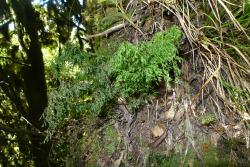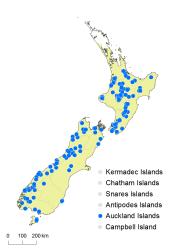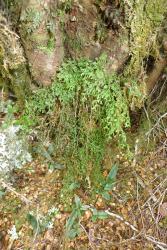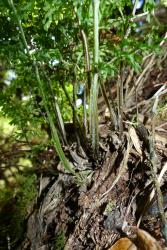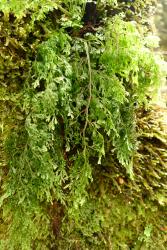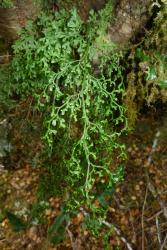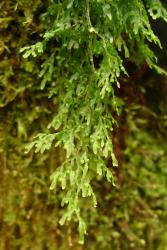- ≡ Mecodium pulcherrimum (Colenso) Copel., Philipp. J. Sci. 67: 24 (1938)
Epiphytic, terrestrial or rupestral ferns. Rhizomes erect or short-creeping, bearing red-brown hairs up to 7 mm long. Fronds 120–720 mm long. Stipes 25–160 mm long, pale brown or red-brown throughout, winged almost to the base, glabrous. Laminae 4–5-pinnatifid, narrowly ovate or ovate or narrowly elliptic, 80–580 mm long, 35–175 mm wide, green, membranous, glabrous. Rachises winged throughout, pale brown, glabrous; rachis wings planate, margins entire. Primary pinnae in 10–20 pairs, usually overlapping, winged throughout, all adnate; distal portion of primary pinnae straight or incurved acroscopically; distal primary pinnae narrowly ovate to ovate; proximal primary pinnae ovate to broadly ovate; the longest primary pinnae below the middle, 35–190 mm long, 20–50 mm wide. Secondary pinnae arising both acroscopically and basiscopically, scarcely overlapping, winged throughout, elliptic to ovate, adnate; the longest secondary pinnae 14–45 mm long, 12–20 mm wide. Ultimate lamina segments oblong, up to 6 mm long, 0.8–1.9 mm wide, planate or slightly flexuous; apices obtuse or truncate or slightly emarginate; margins entire, lacking a distinct border; distal segments on primary pinnae divergent. Sori borne on short acroscopic and basiscopic segments throughout primary pinnae, solitary, many on each primary pinna, adnate; indusia bivalvate; indusial flaps ovate or elliptic or almost orbicular, 1–1.5 mm long, apices obtuse, margins entire; receptacles included within indusial flaps.
Hymenophyllum pulcherrimum is the only New Zealand species of Hymenophyllum to have an erect or short-creeping rhizome. In addition, it can be recognised by its long, pendulous, glabrous and often rather flexuous fronds with winged rachises and stipes. It can sometimes be confused with H. flexuosum but the abundant red-brown rhizome hairs up to 7 mm long in H. pulcherrimum are very different to the scattered pale brown hairs up to 1 mm long confined to the stipe bases of H. flexuosum.
North Island: Auckland, Volcanic Plateau, Gisborne, Taranaki, Southern North Island.
South Island: Western Nelson, Sounds-Nelson, Marlborough, Westland, Canterbury, Otago, Southland, Fiordland.
Stewart Island, Auckland Islands.
Altitudinal range: 40–1170 m.
Hymenophyllum pulcherrimum occurs in lowland to montane areas of the North Island from Mt Te Aroha and Pukeamaru, East Cape southwards, ranging from 200 m in the Wairarapa to 1170 m on Mt Taranaki. In the South Island, it is largely confined to areas west of the main divide, with only scattered populations in inland Canterbury and on the east coast. It ranges from 40 m near Haast to 975 m in the Paparoa Ranges.
Occurs in podocarp, beech and broadleaved forest, growing on rock, banks, rotting logs, at the base of tree trunks or epiphytically. It has been recorded growing on Coprosma sp., Griselinia littoralis, Nestegis cunninghamii, Podocarpus laetus, Weinmannia racemosa and species of Nothofagaceae. Unusually for a species of Hymenophyllum, it does not grow on tree fern trunks.
n = 36 (Brownlie 1961).
Hymenophyllum pulcherrimum was described by Colenso (1845) from collections he made on the shores of Lake Waikaremoana in December 1841. The lectotype was chosen by Allan (1961), citing "Colenso, December 1841" in WELT (now WELT P003271). There is also a specimen at K (Colenso 273) which is a syntype (photo WELT E468/26). Neither specimen bears the month "December" cited by Allan, and this is assumed to have been taken from the protologue.



